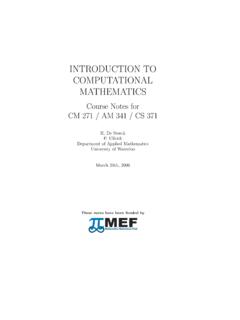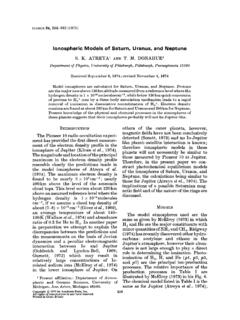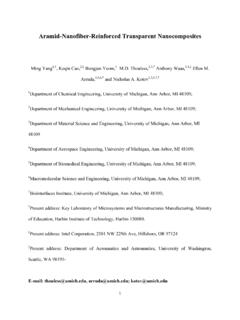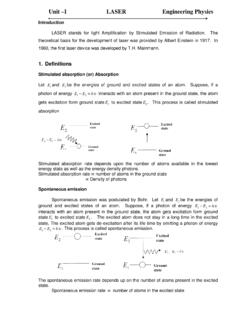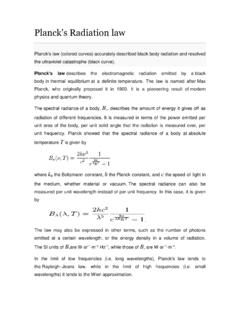Transcription of 4. Canonical ensemble
1 4. Canonical ensembleIn this chapter we will formulate statistical physics for subsystemsthat are held at constant temperature. In the next chapter we willwork at constant temperature and constant chemical potential. Thecalculations are different from those we have done so far, and oftenfar simpler. For systems at fixed temperature there are very usefulnumerical techniques, Monte Carlo methods, that we will :Gibbs gave odd names to methods involving subsystemsin contact with reservoirs. In closed system, with fixed energy we estimate time averages bysampling uniformly over the energy shell, as we have done untilnow. Gibbs called this themicrocanonicalensemble. In a system which can exchange energy at fixed temperature weaverage using the boltzmann factor of Eq.
2 ( ). This is calledthecanonicalensemble. In a system which can exchange both energy and number withreservoirs, we have a different method of averaging that we willderive below. This is called thegrand Averages and the partition functionIn this section we study systems which are subsystems of a largersystem: they are held at constant temperature by contact with a (muchlarger) heat bath. For a system in contact with a heat bath we havealready derived the probability of finding a given energy or a givenstate, Eq. ( ). To review, we say:Wtot=eSr(E Es)/kBWs(Es) e EsWs(Es),P(Ei) exp( Ei).( )HereEilabels a particular quantum state, and =1/kBT. Note thatthis formula holds in general: classical systems and quantum Canonical AVERAGES AND EQUIPARTITION94obey this probability satisfies jP(j) = 1, where the sum is over all thealternatives.
3 Thus we can write, for the Canonical ensemble :P(Ei)=e EiZ;Z= ie Ei.( )The normalization,Z, is called the partition function. The notation,Z, comes from the GermanZustandsumme= sum over states. Inthe chemical literatureZis calledQ. For a classical system we re-place the sum over states by an integral in the same way as for themicrocanonical ensemble :P(E)=1N!h3Ne H(r,p)Z,Z=1N!h3N dNrdNpe H(r,p).( ) Canonical averages and equipartitionThere is a very useful special case of the formalism Distributions of additive degrees of freedomLet us look at the Canonical probability more closely. Suppose thatwe have a classical Hamiltonian in which certain degrees of freedom(coordinates or momenta) appear additively.
4 For example, for an in-teracting fluid,H=p21/2m+N 2p2i/2m+ ({r}).We can find the probability distribution for that variable (the distri-bution forp1in this case) by considering it as will use the relation from probability theory that ifP(AB)istheprobability ofAandB,then:P(A)= BP(AB).The distribution,P(A), is the marginal distribution, the distributionofAignoringB. We can findP(A) by summing over all the possibil-ities may seem to contradict the form of the Fermi and Bose distributions ofEq. ( ), Eq. ( ). It does not, as we will see 4. Canonical ENSEMBLEFor our case, we integrate the normalized probability overpj,j=2,3,..,Nandrj,j=1,2,.., (p1)=e p21/2m dN 1pe N2p2i/2m dNre dNpe N1p2i/2m dNre =e p21/2m dp1e p21/2m( )This is the maxwell - boltzmann distribution which we have seen abovefor the ideal gas.
5 Note that the interactions cancel out in numera-tor and demominator. Any classical system, gas, liquid, or solid (orpolymer, glass, etc.) has this distribution for the momentum of boltzmann equipartition theoremContinuing in the same vein, consider the average of any quantity thatappears in the Hamiltonian as an additive term which is quadratic ina degree of freedom:H=H ({q, p})+ ,{q, p}denotes all the other variables. Then, in the same way asin Eq. ( ) we have: CQ2 = dQ CQ2e CQ2 dq dp e H dQe CQ2 dq dp e H = dQ CQ2e CQ2 dQe CQ2= ln[ dQe CQ2]=kBT2.( )This theorem quickly gives many results. For example, the averageinternal energy of the ideal gas is:E= N 1p2i/2m =3 heat capacity follows:CV= E/ TV=3 another example, air is composed, almost entirely, of the diatomicmolecules O2and N2.
6 We can model them as rigid rotors with Canonical AVERAGES AND EQUIPARTITION96of intertiaI. Then the kinetic energy has extra degrees of each type of molecule we can write:E= j[p2j/2m+L2j/2I].( )The angular momentum vectorLshould be regarded as having twocomponents in our classical picture we neglect the moment of inertiaaround the molecular axis. Thus we have two more degrees of freedom,and E =3N(kBT/2) + 2N(kBT/2) = (5/2) first term is the translational part and the second rotational. ThusCV=(5/2)NkB,Cp=(7/2)NkB. (The last identity comes from thethermodynamic relation for ideal gases,Cp=CV+NkB. The proofis left as an exercise.)This is simple, and gives answers in agreement with , it is quite puzzling in one respect: if we think of diatomicmolecules classically, we should consider that they can vibrate.
7 Thesimplest model for a diatomic molecule with a chemical bond wouldbe two masses connected by a spring. The spring should give anotherquadratic degree of freedom, and anotherkBT/2 per molecule in theenergy. This is not observed. This fact was extremely troubling to thefounders of statistical thermodynamics; see Gibbs (1902). The expla-nation is that the vibrations must be treated in quantum mechanics,and equipartition does not hold in quantum can apply these ideas to a solid as well. The simplest model forthe vibrations of a monatomic solid is due to A. Einstein. Einsteinnoted that in a solid in equilibrium each atom sits at the minimumof the potential well due to all of the other atoms.
8 Expanding aboutthe minimum means that each atom is in a quadratic potential, andif an atom moves away from equilibrium, the force is of the form Kr(assuming isotropy). Then the energy isKr2/2m,whereKis aspring constant andmis the atomic mass, so that the frequency of thevibration is E= K/m. There are three more quadratic degrees offreedom. We find, as before:CV=3 NkB2(kinetic) +3 NkB2(vibrational) = 3 NkB.( )This is called the law of Dulong and Petit; it was discovered empiricallyby P. L. Dulong and A. T. Petit in law is quite a lot more general than this derivation seems toimply. In fact, if we letNdenote all the atoms in a molecular solid, it97 CHAPTER 4. Canonical ENSEMBLEF igure : The Einstein model forCVas a function ofT/TEwherekBTE= E.
9 The upper line is the Dulong-Petit law, andthe lower dotted line schematically depicts the deviation of thetheory from experiment at very as well. The reason is this: in the Einstein model each atomis thought to vibrate independently. In fact, all of them are coupledso that the real excitations are waves of vibration, sound Hamiltonian is quadratic in the amplitude and momentum of thewaves, and we have as many different waves as we have degrees offreedom. How this works out the normal mode transformation willbe treated in Chapter , well below room temperature, the Dulong-Petit law fails,andlimT 0CV=0,as required by the third law. A quantum mechanical treatment ofthe Einstein model gives this result; see Figure We will do thisderivation below.
10 The real situation in solids is qualitatively like theEinstein model with a deviation at very THE PARTITION FUNCTION AND THE FREE The partition function and the free energyThe partition function is of physical significance itself, as shown bythe following F;F= kBTlnZ.( ) First proof: average ofFWe will show this in two ways. First we need to interpretFin theequation. RememberF=E TS(E), andEvaries as heat flowsin and out of the system from the heat bath. In fact, the quantityof interest is F = E Tr S . In order to emphasize that thetemperature is fixed by the reservoir, we writeTr. Now from Eq. ( )and Eq. ( ) we have: F = E Tr S =1Z i(Ei+kBTrlnP(Ei))e Ei=1Z i(Ei kBTr[ Ei+lnZ])e Ei= kBTrlnZ.




